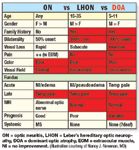Article
Boy has decreasing visual acuity
The differential diagnosis of a hereditary optic neuropathy includes four possible disease categories.

Dr. Newman described the step-by-step rationale for diagnosing the case of an otherwise healthy 14-year-old boy who presented with decreasing visual acuity (VA) over the previous few years. His brother also had poor vision. The patient's vision was 20/60 bilaterally. The pupils were equally sluggish without an afferent pupillary defect. The optic discs were slightly pale. The visual fields had a superior temporal defect bilaterally. Magnetic resonance imaging (MRI) studies were normal.
When considering a case such as this, the first step is to localize the pathology, in this case, bilateral optic neuropathy, and then consider the list of possible causative mechanisms, she advised. Dr. Newman is the Leo Delle Jolley Professor of Ophthalmology, professor of ophthalmology and neurology, instructor in neurological surgery, Emory University School of Medicine, Atlanta; lecturer in ophthalmology, Harvard Medical School, Boston; and director, Section of Neuro-Ophthalmology, Emory Eye Center.

"Previous unrecognized optic neuritis should remain as a possible entity in the differential diagnosis," she said.
However, she emphasized, the main disease process to consider in a case such as that under discussion is a hereditary optic neuropathy.





